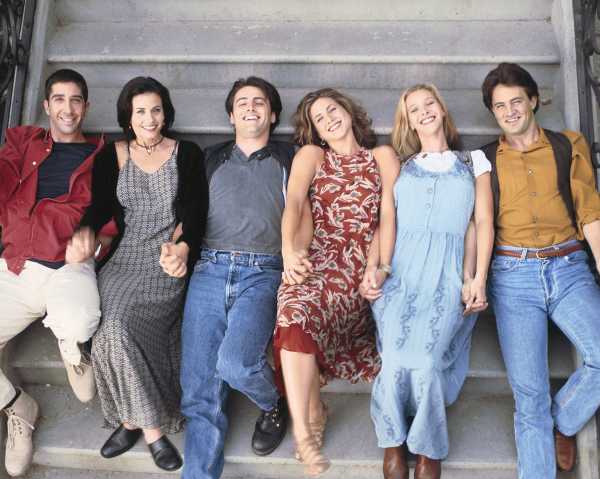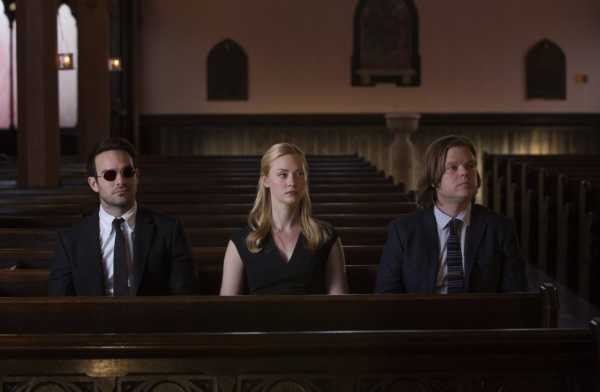
A great panic recently swept across the internet. Friends was leaving Netflix!!
For a portion of the first few days of December, the popular sitcom’s landing page on the streaming network noted that the show would no longer be available as of January 1 because the contract that Netflix signed to begin streaming Friends in 2015 was due to expire.
But on Monday, December 3, Netflix’s chief content officer, Ted Sarandos, dismissed Friends leaving the service as “a rumor” (albeit one apparently started by his own company) and the language about Friends leaving the network was pulled. Netflix confirmed that the show would remain part of its streaming catalog “throughout 2019.” All was well!
The hue and cry over the threat of Friends leaving Netflix was similar to the hue and cry over a piece of big Netflix news from the week before, when the service unceremoniously canceled the Marvel superhero series Daredevil — the network’s fourth most popular original show, by some estimations — on Thursday, November 29. In short, people were mad at Netflix for not making sure that Friends would be available to stream in perpetuity, just as people had been mad at Netflix for canceling the show.
Their anger made sense in the case of Daredevil, because it was Netflix that decided to pull the plug on the show. But it made a lot less sense in the case of Friends, where Netflix has little say over whether it retains the show’s streaming rights if WarnerMedia, the company that consists of Warner Bros., HBO, and Turner and which controls the rights to Friends, isn’t interested in extending its deal.
And if subsequent comments from the CEO of AT&T, the parent company of WarnerMedia, are any indication, then the nonexclusive deal that Netflix cut to keep Friends streaming is one that should concern anybody who has cut the cord to save money on cable TV. The streaming era is on the precipice of becoming just as expensive as the cable era. And both the Daredevil cancellation and the Friends deal explain why.
Netflix, explained

Though it’s easy to forget, Netflix began its life as a direct-mail DVD rental service. It bought thousands of movies and TV shows on DVD, then shipped them through the mail to customers all over the country. But it was not making those movies and TV shows or manufacturing those DVDs. It was purchasing them from the studios that produced them and shipping them directly to you, so you could watch them and then return them. And while Netflix not making the content it was providing isn’t a perfect metaphor for how the company operates in the streaming era, it’s going to get us close enough.
In the late 2000s and early 2010s, Netflix quietly began locking down the rights to stream much of the content it was also purchasing on DVD. If you were on Netflix’s streaming service in, say, 2011, it was kind of a remarkable era. It felt like everything was there. In reality, Netflix’s streaming catalog was a pale shadow of what the company had in DVD inventory, but back then, the various companies that controlled streaming rights to films and TV shows didn’t see why they should be so concerned about selling those rights for a song.
And so Netflix streaming became an endless scroll of programs, from recent movie hits to schlocky stuff that budget studios were just happy to have somebody pay any money for at all. For media nerds who didn’t like leaving the house — and who also didn’t mind the often shoddy video quality of Netflix’s early streaming platform — it was heaven.
This was also the era when TV networks started to realize how much value there was in making sure their shows were available to stream on Netflix or Hulu (the only other major streaming competitor in existence in the early 2010s in a form that more or less mirrors its current one).
The classic example has always been Breaking Bad, a show whose ratings struggled to justify its renewal for several seasons, but also a show that concluded its run with more than 10 million viewers tuning in for its finale. Series creator Vince Gilligan has cited the show’s presence on Netflix as a big part of its audience development.
But by putting their content on Netflix, the studios were also accidentally creating a competitor that had eyes on being just like them. Beginning in earnest with the launch of House of Cards in February 2013, Netflix soon began producing its own original programming. (Lilyhammer, a mostly forgotten mob series that was technically the first Netflix original, was an overseas acquisition.)
However, the company wasn’t (yet) set up to produce that original programming all on its own, so it also signed contracts to purchase exclusive streaming rights to certain programs coming from other production houses. In the case of three early Netflix successes, those houses were Media Rights Capital, which owns House of Cards; Lionsgate Television, which owns Orange Is the New Black; and Tornante, which is run by former Disney head Michael Eisner and owns BoJack Horseman.
These companies have always controlled the other rights to their programs, which is how, for instance, both House of Cards and Orange Is the New Black have landed on DVD, while BoJack Horseman airs in reruns on Comedy Central. Netflix has no control over what happens to these series after they first run on Netflix.
Meanwhile, Netflix has continued to buy streaming rights to existing content from other networks and studios. It has made blockbuster deals for NBC’s The Blacklist, much of the programming on The CW, and old hits like Friends. And while there’s no hard data on whether Netflix subscribers watch all, some, or none of the network’s original programming, what evidence we have suggests there’s still a lot of viewing of old favorites on the platform. It’s not hard to imagine that old favorites may even account for most of what subscribers watch. (At least one survey of UK Netflix subscribers concluded that Friends was the most-watched show on the service in that region.)
Netflix responded to the early problem of not controlling all of the rights to some of its biggest original hits first by spending more money to lock down exclusivity for shows it bought from other studios (like a blockbuster deal for the drama Bloodline, which fizzled after three seasons). But eventually, it started making more and more of its own shows. If it owned the programs outright, then nobody would be able to pull them from the service for as long as Netflix existed.
Making your own shows is expensive, however. And as companies like WarnerMedia began to realize just how valuable all those Friends reruns really were, they started thinking about building their own streaming services. Which made it seem sillier and sillier to let Netflix have access to their shows, even for limited windows of time. After all, did people subscribe to Netflix because they were loyal to Netflix? Or was it because Netflix made it so easy to watch their favorite shows?
Put another way: Would you still subscribe to Netflix if it only had Netflix originals? It’s a question you might be asking yourself in five years.
And all of the above brings us to the events of the past couple of weeks.
How Daredevil’s cancellation and the Friends deal are the same story about the rapid reinvention of an entire industry

Netflix’s business model doesn’t require it to attain a virtual monopoly on the entertainment landscape in the near-ish future, but it would sure help. The company is, in essence, in the process of turning itself from a video store, which had to maintain a symbiotic relationship with movie studios, into a studio itself. But because it also controls its own means of distribution, it can, effectively, evolve into an entire media ecosystem of its own, provided it has enough programming that you want to keep watching.
Companies like WarnerMedia and Disney (which controls the rights to Daredevil through its ownership of Marvel, which produced the show for Netflix) are currently betting that your loyalty to their various programs and films is ultimately going to prove more sustainable than your loyalty to Netflix. Hence, when both companies start their own streaming services in the near future, they’re likely going to feature many programs that were popular on Netflix — but are no longer available there.
Related
Disney announces it’s ditching Netflix to start its own streaming service
This bet makes a certain amount of sense! It’s hard to argue against the cultural omnipresence of Mickey Mouse and Star Wars, of Friends and Superman, especially when Netflix’s biggest pop culture icon is probably Stranger Things, a huge series but a drop in the bucket compared to, say, Game of Thrones (whose rights are controlled by WarnerMedia’s HBO).
Netflix, meanwhile, has also started to jettison shows produced by other studios while it simultaneously attempts to shore up its own production arm and holds onto a handful of key programs from other studios that people are fond of (like Friends or The Office). The chief beneficiary of this strategy has been Hulu, which is a joint venture of several different studios and has been scooping up abandoned Netflix licenses left and right, especially in a huge 2017 deal with 20th Century Fox (which itself will almost certainly become part of Disney) that netted it dozens of shows and more than 3,000 episodes of TV.
Related
What 30 Rock’s move from Netflix to Hulu can tell us about the future of streaming
Netflix, in essence, needs to ensure that the original series it produces itself are the centerpiece of its strategy, because it has no real control over what ultimately happens to so many of its other shows. American Vandal (produced by CBS Studios) and Daredevil (produced by Marvel) are examples of shows that Netflix will eventually, someday, have to renegotiate the rights for, and like all networks, the service is getting cagier about renewing and picking up shows it doesn’t make itself. (Read more about this here.)
Understandably, the complicated morass of corporate wrangling that goes into a streaming contract is something that few viewers are aware of, even if you watch to the end of the credits to see who produced the show, rather than letting autoplay start the next episode. So when Netflix cancels Daredevil or seems to be slacking on renewing its deal for Friends, it’s easy for viewers to leap to the conclusion that “Netflix is doing something stupid!”
But also of note in the Friends deal is what AT&T chair and CEO Randall Stephenson ultimately revealed at the UBS Global Media and Communications Conference: that the show is no longer exclusive to Netflix. This means that not only can WarnerMedia sign a deal to license Friends to Netflix, but it can also put Friends on its own streaming service, which is expected to launch in late 2019.
And Netflix’s deal for Friends expires in 2020. So who’s to say WarnerMedia won’t just take back Friends’ streaming rights entirely at that point? If you really want to watch Friends and this future WarnerMedia-affiliated platform is the only place to get it, it might become much more tempting than a Friends-less Netflix.
This crisis is looming for Netflix in particular, but also for Amazon, for a proposed new streaming service from Apple, and for whatever’s going on with Facebook and YouTube’s forays into original programming. (Hulu looks like it’s about to be owned by Disney, thanks to the proposed Disney/Fox merger, which would give it a parent company with massive pockets and a massive entertainment library.)
Both Netflix and Amazon are huge, with many subscribers, but it’s not clear to outside observers how many of their customers are subscribing because they want to watch programs that the platforms don’t control the rights to.
Netflix, which invested at least $8 billion in programming this year, certainly has the money to compete, but making TV and movies is an expensive proposition, and it sure helps when you’ve got access to back catalogs full of stuff that people already know they love. That’s true for Disney and WarnerMedia especially, and true for the other handful of big studios and networks to a slightly lesser degree. So what happens when all of them launch their own streaming services, each of which will have one or two of your favorite shows?
It strikes me as inevitable that cord-cutting consumers will eventually return to the place they were trying to escape when they subscribed to any given streaming network — and in that place, they’ll likely find an expensive monthly bill that bundles together a bunch of different services and keeps escalating in price as more and more are added.
And since cable companies currently control a lot of the US’s broadband connections and have experience in grouping channels into tiered packages, they’re probably going to end up at the forefront of whatever this new movement looks like.
This evolution won’t take years. With both Disney and WarnerMedia planning to launch their services in 2019, it’s likely going to happen in a matter of months. The cable bundle died so its souped-up younger brother could live.
Sourse: breakingnews.ie
0.00 (0%) 0 votes


































